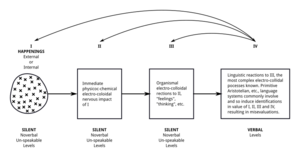General semantics facts for kids
General semantics is a way of thinking about how we understand the world around us. It helps us see how our words and thoughts shape what we believe. This idea was created by a man named Alfred Korzybski in the 1920s and early 1930s.
The main idea of general semantics is simple: what we say or think about something is never the whole story. When we simplify something, either in our minds or with words, that simplified idea is not the same as the real thing. General semantics teaches us that there is always more to learn about something than what we see, hear, feel, or believe.
Contents
What is General Semantics?
General semantics is a special kind of philosophy. It helps us understand how people react to the world based on the meanings they give to things. It teaches us to be more aware of how we use language and how our thoughts work.
Understanding Reality
One key part of general semantics is knowing that our understanding of reality is not the same as reality itself. This is because people cannot know absolutely everything about anything. We only know parts of it.
The Map is Not the Territory
A famous idea in general semantics is "the map is not the territory." Imagine you have a map of your town. The map helps you find places, but it's not the actual town. It's a drawing, a simplified version. The real town has smells, sounds, and people moving around.
In the same way, our words and thoughts are like maps. They help us understand the world, but they are not the world itself. They are simplified versions of a much bigger, more complex reality.
Why This Idea Matters
This idea is important because it helps us avoid misunderstandings. If we remember that our "maps" (our ideas and words) are not the "territory" (the real thing), we can be more open to new information. We can also be more careful about how we talk and think.
Who Started General Semantics?
General semantics was developed by a Polish-American scholar named Alfred Korzybski. He was born in 1879 and passed away in 1950. Korzybski was interested in how people think and communicate.
Korzybski's Background
Alfred Korzybski studied engineering and mathematics. He also served in World War I. These experiences made him think deeply about how people use language and how it can lead to problems or solutions. He saw how misunderstandings could cause big issues.
When it Began
Korzybski started developing his ideas in the 1920s. He published his main book, "Science and Sanity: An Introduction to Non-Aristotelian Systems and General Semantics," in 1933. This book explained his new way of thinking to the world.
Why is General Semantics Important?
General semantics aims to help people think more clearly and communicate better. It encourages us to be more aware of our own thinking habits.
Improving Communication
When we understand that our words are just symbols, we can communicate more effectively. We learn to ask questions and listen carefully. This helps us avoid arguments that come from different understandings of the same words.
Thinking More Clearly
General semantics helps us realize that we often make quick judgments. It teaches us to slow down and consider that there might be more to a situation than we first think. This can lead to better decisions in our daily lives.
Avoiding Oversimplification
Sometimes, we simplify things too much. For example, if someone says "all dogs are mean," that's an oversimplification. General semantics helps us see that each dog is unique. It encourages us to look at individual details instead of making big, general statements.
Being Open to New Ideas
By understanding that our knowledge is always incomplete, we become more open to learning new things. We realize that there's always more to discover about people, places, and ideas. This helps us grow and adapt.
How Can We Use General Semantics?
You can use the ideas of general semantics in your everyday life. It's about being more mindful of your thoughts and words.
Asking Questions
Instead of assuming you know everything, ask questions. For example, if someone says "that movie was bad," you could ask, "What specifically did you not like about it?" This helps you get more details.
Being Specific
Try to be specific when you talk. Instead of saying "I had a bad day," you could say, "I felt frustrated because my homework was difficult." This helps others understand you better.
Remembering "To Be Continued"
Think of everything you know as "to be continued." This means there's always more information out there. It helps you stay curious and avoid thinking you have all the answers.
General semantics is a tool for better understanding. It helps us navigate the world with more awareness and less misunderstanding.


